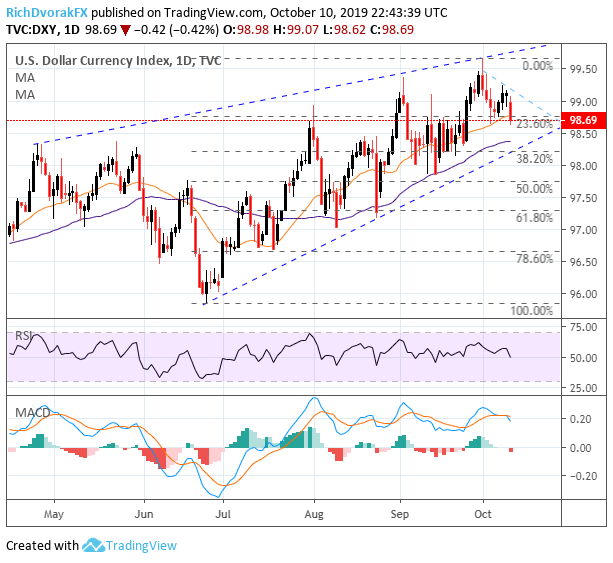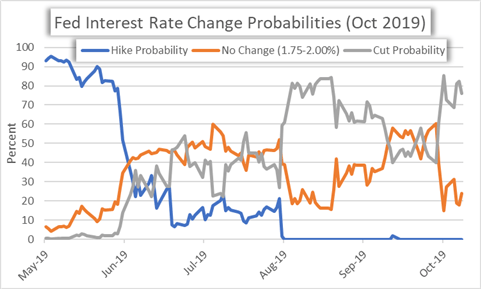US DOLLAR CURRENCY VOLATILITY STILL ELEVATED WITH CONSUMER SENTIMENT REPORT ON DECK
- The US Dollar slid below confluent support on Thursday and leaves the greenback exposed to further downside as recent USD price action gets overshadowed by counterpart strength
- Forex traders will likely turn to the upcoming consumer sentiment report release as markets await further details on US-China trade talks to gauge the dollar’s next direction
- For comprehensive fundamental and technical insight on the US Dollar, download our free 4Q-2019 Forecasts and Trading Guides
The US Dollar came under pressure during Thursday’s trading session, which pushed the DXY Index below a critical support level. USD price action could still gravitate back above this confluent area, however, seeing that downside was driven more-so by counterpart strength rather than greenback weakness. Specifically, EURUSD surged after September ECB minutes confirmed division amongst the central bank’s officials while GBPUSD skyrocketed on renewed Brexit deal hopes. EURUSD and GBPUSD comprise 57.6% and 11.9% of the DXY Index respectively.
US DOLLAR INDEX PRICE CHART: DAILY TIME FRAME (APRIL 17, 2019 TO OCTOBER 10, 2019)

Chart created by @RichDvorakFX with TradingView
The latest stretch of US Dollar selling pressure pushed the RSI back to 50 and caused the MACD indicator to roll over as bearish momentum gains pace. That said, the DXY Index remains exposed to further downside since breaching the 23.6% Fibonacci retracement level and 20-day simple moving average. If the DXY Index fails to quickly reclaim this major level of confluence, forex traders will likely look to the US Dollar’s 50-DMA and bullish trendline extended from its series of higher lows since mid-June for potential support.
In addition to the aforementioned technical support zone, the US Dollar’s fundamental backdrop seemingly improved over the last 24-hours, which could help keep USD price action relatively anchored. The September FOMC minutes published on Wednesday underscored how Fed officials are virtually split over whether to cut interest rates further or not, while another sticky core CPI datapoint has potential to undermine the central bank’s ability to provide additional monetary policy accommodation.
US CONSUMER SENTIMENT EXPECTED TO DECLINE AS TRADE UNCERTAINTY, RECESSION RISKS WEIGH

The University of Michigan’s headline consumer sentiment index ticked slightly higher over the preceding period – likely driven by improving US-China trade tensions despite Trump’s tariff whiplash. Still, there’s strong potential that Friday’s consumer sentiment report for September disappoints, which would mirror the recent plunge in the Conference Board’s Consumer Confidence Index. Also, considering sentiment surveys are often believed to be lagging indicators, the frightening treasury yield curve inversion witnessed late August might not have been fully reflected in the previous consumer sentiment report.
Consumer attitudes could grow more sanguine regarding economic outlook and future spending plans, however, seeing that the Federal Reserve just provided back-to-back interest rate cuts hoping to boost inflation and insure against rising downside risks. Yet, the impact that central bank policy action has takes time to trickle its way into the economy and could be overshadowed by the dismal manufacturing and services PMI reports published two weeks ago.
US-CHINA TRADE TALKS REMAIN BIGGEST RISK TO USD PRICE ACTION
Nevertheless, US-China trade talks are supposedly still scheduled to continue on Friday despite conflicting reports from Washington and Beijing. It is rumored that negotiators from the US and China are weighing a potential currency pact as part of a preliminary trade deal, which could provide the White House with a reason to delay the 5% tariff hike on $250 billion of Chinese goods currently scheduled to take effect on October 15.
That said, markets have been enticed with similar headlines before that have previously failed to bear any fruit. Consequently, effective implementation of risk management techniques is imperative in light of elevated volatility caused by the trade war headlines lobbed back and forth between parties, which is likely to persist until a tangible agreement actually materializes.
FEDERAL RESERVE INTEREST RATE CUT PROBABILITIES (OCTOBER 2019)

Alas, US Dollar price action will likely be driven largely by the market’s priced expectations for future FOMC interest rate cuts, which stand to respond materially to the latest US-China trade war developments and upcoming consumer sentiment report. According to the latest overnight swaps data, traders are currently pricing a 75.9% probability that the Fed lowers its policy interest rate by at least 25-basis points for a third consecutive meeting later this month.
US DOLLAR IMPLIED VOLATILITY & TRADING RANGES (OVERNIGHT)

As previously mentioned, US Dollar implied volatility remains elevated as US-China trade talks and high-impact economic data lurk on the horizon, which stand to sway Fed monetary policy decisions. GBPUSD is expected to be the most volatile USD currency pair on Friday with an overnight implied volatility of 13.6% in light of the latest Brexit developments. Similarly, currency options traders still expect heightened price action in spot USDCNH as its overnight implied volatility reading of 7.9% ranks in the top 95th percentile of measurements taken over the last 12-months.
Also, sentiment-linked USDJPY could get a sizable jolt during Friday’s trading session – particularly if there’s a sharp rise in Fed rate cut bets that fuel a Yen breakout. Furthermore, keep USDCAD on the radar seeing that the Canadian Dollar is at risk ahead of the upcoming jobs report and BOC meeting.
-- Written by Rich Dvorak, Junior Analyst for DailyFX.com
Connect with @RichDvorakFX on Twitter for real-time market insight






